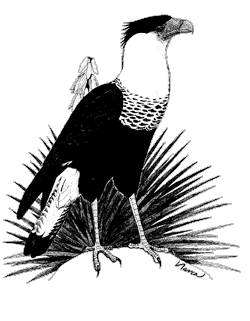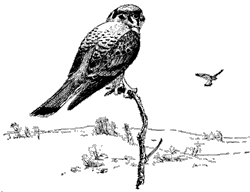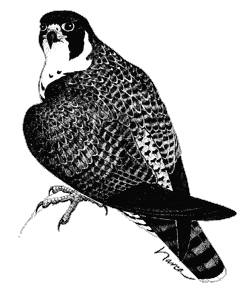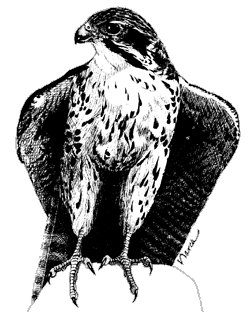Caracaras & Falcons
Some of the world’s most impressive fliers belong to the falcon family. Typical falcons are trim birds of prey, with long tails and angular, pointed wings, built for breath- taking speed and maneuverability in the air.
 |
Our most familiar falcon, the American Kestrel, is also our smallest, about the size of a Mourning Dove. Kestrels nest in large cavities in trees, or in holes in saguaro cacti. Although they can put on bursts of speed when they are pursuing rodents or small birds, most of their diet consists of large insects; their fanciest flying trick is their ability to hover in one spot, on rapidly beating wings, while they scan the ground for prey.
Prairie Falcons are much larger, but surprisingly maneuverable for their size. When pursuing small birds in the open, they can twist and turn with amazing agility. Peregrine Falcons are similar in size, but rely on different hunting techniques, usually power-diving from considerable heights to take their prey by surprise. In these dives, Peregrines are thought to approach 200 miles per hour (320 km per hour). Prairie Falcons are native to the American West, while Peregrines range almost worldwide; both occur in the Sonoran Desert in small numbers at all seasons.
Classified in the same family, but far different in structure and habits, are the Caracaras. Our Crested Caracara is a broad-winged, slow-flying scavenger, often competing with vultures at road kills and other carcasses. Mainly a tropical bird, it is most common in the southern parts of the Sonoran Desert.
—Kenn KaufmanCaracaras and Falcons
 |
Sonoran Desert species:
Crested Caracara (Caracara plancus)
American Kestrel (Falco sparverius)
Prairie Falcon (Falco mexicanus)
Peregrine Falcon (Falco peregrinus)
Order: Falconiformes
Families: Falconidae
Spanish names: quebrantahuesos (Crested Caracara), gavilan pollero (Kestrel),
halcon café (Prairie Falcon), halcon pollero (Peregrine Falcon)
Distinguishing Features
The Crested Caracara has a black-brown body, white neck and throat, red-orange face, black head and long yellow legs; it has round wings and lacks the speed of falcons; its flight is direct and noisy. In flight the white base of the tail and white patch on the tips on the wings contrast with the black body.
Click to hear Crested Caracara sounds
The American Kestrel is the smallest falcon in the United States with a wing-spread is less than 2 feet; back and tail are rust-brown; it has a black and white head pattern. Males have blue-gray wings and a more rust colored tail than females, which are brown overall, except for the lighter breast.
The Prairie Falcon is medium-sized with a pale, sandy-brown back; its underparts are white and heavily spotted; the crown is streaked and the helmet has a thin dark mustache. In flight the Prairie Falcon shows a black patch under the base of each wing. Sexes are similar.
The Peregrine Falcon is medium-sized to large, with a black “helmet” or “hood” covering the top of the head and extending below the eye. Adults have blue-gray backs and barred underparts, while young birds have dark brown backs and striped underparts.
Habitat
The Caracara inhabits arid, open country at low elevations such as desert brushlands, plains, and savannahs. It is sometimes seen at livestock or slaughter yards. The American Kestrel is found in open habitats, grasslands, deserts, and cities. The Prairie Falcon occurs in canyons, open country, grasslands, and deserts. The Peregrine Falcon can be found in deserts, mountains, and forests where tall cliffs occur. Both Peregrines and Prairie Falcons are sometimes found around tall buidings in cities.
Feeding
• Diet: The Caracara feeds on carrion and live-caught prey such as small mammals, insects, reptiles, frogs, nestlings, weak or injured birds, and eggs. The American Kestrel feeds mainly on insects. The Prairie Falcon preys on small mammals, reptiles, insects, and ground dwelling birds. Peregrines prey primarily on doves, waterfowl, shorebirds, and passerines.
 |
• Behavior: The Caracara, whose flight is direct and steady, soar for extended periods looking for carrion. It is often found feeding with and harassing vultures.
American Kestrels take smaller and slower prey than the other falcons. During hunting they use rapid wingbeats and hover in one spot before plunging to catch their prey. In the desert, Kestrels hunt in the morning and late afternoon during summer; during winter they are active throughout the day.
Falcons have long tails and long, narrow, pointed wings designed for speed. They have tooth-like projections along the cutting edge of the mandibles that are used to kill prey quickly by severing the spinal cord with a sharp bite. The Prairie Falcon flies low over the ground or soars looking for prey. Its flight is swift and more maneuverable than that of the Peregrine.
The Peregrine Falcon catches birds in flight by diving and taking them by surprise. This falcon strikes its prey with its feet and returns to catch the falling bird. Pairs hunt cooperatively when not nesting.
Life History
 |
The Caracara is adapted for walking and hunting on the ground. The bulky, loose nests are placed on the ground or in a tree and are made of twigs and sticks.
Kestrels are cavity nesters using holes in saguaros, trees, telephone poles and buildings. Eggs (4 to 5) are cared for by both of the parents. The young leave the nest in about 30 days. Kestrels have only 1 brood per year.
Both the Prairie Falcons and Peregrine Falcons nest on ledges or cliff sites. The male Peregrine Falcon usually does most of the hunting during nesting and the female broods and feeds the chicks. Falcon populations were in decline before ddt was banned in 1972. Today Prairie Falcon populations are stable and do not appear to be suffering from the past pesticide problems. Peregrine Falcon populations have also rebounded in the United States since the ban.










